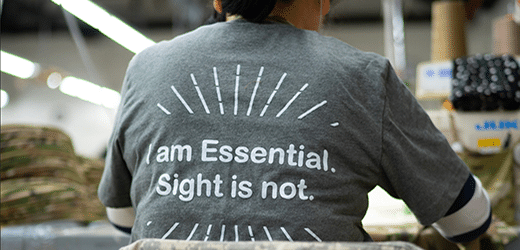6 Holiday Meal Tips for People with Low Vision

By Becky Dumsky, Alphapointe Activities of Daily Living Instructor
Low vision can make ordinary routine tasks much harder to complete during any time of the year, but it can be especially more difficult during the holiday season. Here are six tips that might be helpful to reduce the amount of stress a person with low vision may have while engaging in holiday meals with family and friends. These can be implemented by sighted people and/or people with low vision and can even be helpful for someone who doesn’t’ have a vision impairment because they increase visibility at mealtimes.
Tablecloth Contrast
Use a solid color tablecloth or placemat for the table that contrasts with the dishes that will be placed on the table. For example, if your dishes are white, then a dark solid tablecloth/placemat would be best. If your dishes are dark, a white solid tablecloth/placemat would be best. This allows a visually impaired person to better see the items on the table and reduces the possibility of mistaking an item for something else or knocking something over because it wasn’t seen.
Plate Contrast
Use plates with a dark border around the edge of the plate, but white inside the border. The white portion of the plate increases the visibility and allows a visually impaired person to see the food on the plate better. The border assists with identifying the edge of the plate and where the table or tablecloth begins (as long as the border contrasts with the table and/or tablecloth). If you already have plates with borders around the edge, then you’re a step ahead of the game. If not, try finding paper plates with borders around the edge and white inside the border.
Napkin Contrast
Use napkins that contrast with the tablecloth. If your tablecloth is white, use red, green or some other dark color. If your tablecloth is dark, then white napkins are perfect!
Lighting is Key
Make sure to have good lighting because some visually impaired people need all the light they can get. As long as the person isn’t sensitive to light, try changing the bulbs above your dining table to LED lights with 800 lumens and 5,000 kelvins. That information can be found on the box under the lighting facts just like you would find on a nutrition label on a package of food. If the person is sensitive to light, try a lower lumen level or the same lumens with a 2,700 or 6,500 kelvin bulb. There’s a lot of talk about LED lights and lumens, but the kelvin is usually more important for a visually impaired person. These lights are fairly inexpensive – I bought a 4-pack of LED light bulbs at a hardware store that were 800 lumens and 5,000 kelvins for $5.95. What a difference it makes!
Always Ask First
If you are a sighted person, make sure not to assume someone with a visual impairment needs help. Always, always, always ask first! A visually impaired person wants to be independent as much as anybody else.
Don’t Be Shy
Finally, if you are a visually impaired person, don’t’ be afraid to ask for help. We know you want to be independent as much as a sighted person, but it is okay to ask for help when needed. Everybody, whether sighted, visually impaired or completely blind needs help from time to time.
Learn more about Alphapointe’s rehabilitation and training services for people with low vision.
Becky Dumsky is an occupational therapy assistant with nearly 10 years of low vision teaching experience who has helped hundreds of people with low vision regain independence in their lives.





